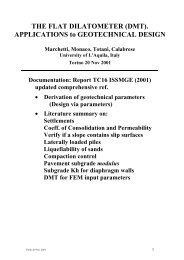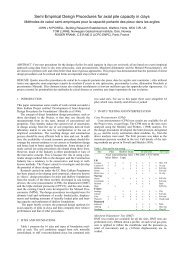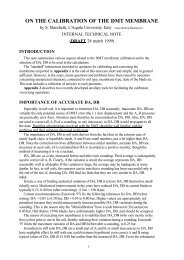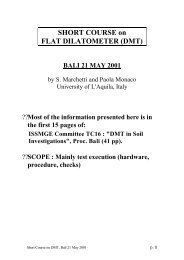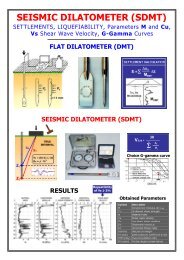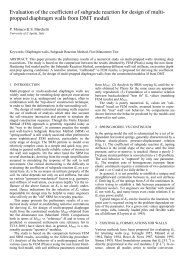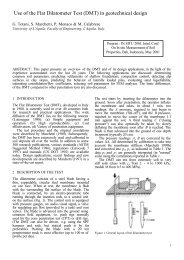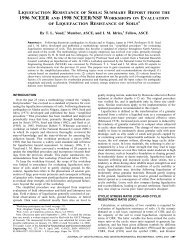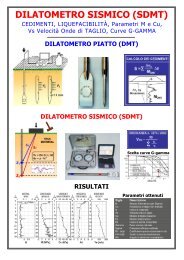(SDMT) in non-penetrable soils - Marchetti DMT
(SDMT) in non-penetrable soils - Marchetti DMT
(SDMT) in non-penetrable soils - Marchetti DMT
You also want an ePaper? Increase the reach of your titles
YUMPU automatically turns print PDFs into web optimized ePapers that Google loves.
L'Aquila – Piazza del Teatro. Also <strong>in</strong> this case the values of V S<br />
obta<strong>in</strong>ed by <strong>S<strong>DMT</strong></strong> are <strong>in</strong> keep<strong>in</strong>g with V S values expected for<br />
the soil types recognized <strong>in</strong> the borehole log. The values of V S<br />
<strong>in</strong> the breccia are very high (≈ 600-1000 m/s) and <strong>in</strong>crease with<br />
depth. The dispersion of the V S values possibly reflects the<br />
variability <strong>in</strong> soil properties due to the variability <strong>in</strong> sandy or<br />
silty-sandy matrix and cementation typical of this material.<br />
5 CONCLUSIONS<br />
Figure 7. Sulmona (Scuola Masciangioli) – Profiles of V S by <strong>S<strong>DMT</strong></strong> <strong>in</strong><br />
backfilled borehole, V S by Down-Hole and stratigraphic profile<br />
The results presented <strong>in</strong> this paper <strong>in</strong>dicate that the seismic<br />
dilatometer (<strong>S<strong>DMT</strong></strong>) can be advantageously used for obta<strong>in</strong><strong>in</strong>g<br />
measurements of V S (and of the small stra<strong>in</strong> shear modulus G 0<br />
determ<strong>in</strong>ed from V S ) <strong>in</strong> backfilled boreholes <strong>in</strong> <strong>non</strong>-<strong>penetrable</strong><br />
<strong>soils</strong>, commonly encountered <strong>in</strong> many seismic areas, e.g. <strong>in</strong> the<br />
Apenn<strong>in</strong>es regions <strong>in</strong> Italy. The possibility of such measurement<br />
descends from the fact that the path of the shear wave from the<br />
surface to the upper and lower receiver <strong>in</strong>cludes a short path <strong>in</strong><br />
the backfill of very similar length for both receivers.<br />
Comparisons at various sites, presented <strong>in</strong> this paper,<br />
<strong>in</strong>dicate that the true-<strong>in</strong>terval V S measurements obta<strong>in</strong>ed by<br />
<strong>S<strong>DMT</strong></strong> <strong>in</strong> backfilled boreholes, typically every 0.5 m of depth,<br />
provide more detailed and realistic profiles of V S compared to<br />
traditional techniques (e.g. pseudo-<strong>in</strong>terval Down-Hole<br />
method). Hence the <strong>S<strong>DMT</strong></strong> could be an alternative/<strong>in</strong>tegration<br />
to commonly used techniques to obta<strong>in</strong> reliable and detailed V S<br />
profiles <strong>in</strong> hard <strong>soils</strong>/soft rocks.<br />
ACKNOWLEDGMENTS<br />
<strong>S<strong>DMT</strong></strong> <strong>in</strong>vestigations at Sulmona and L'Aquila were funded by<br />
Regione Abruzzo.<br />
REFERENCES<br />
Figure 8. L'Aquila (Piazza del Teatro) – Profile of V S obta<strong>in</strong>ed by<br />
<strong>S<strong>DMT</strong></strong> <strong>in</strong> backfilled borehole and stratigraphic profile<br />
(c) The values of V S obta<strong>in</strong>ed by <strong>S<strong>DMT</strong></strong> are substantially <strong>in</strong><br />
agreement with the V S obta<strong>in</strong>ed by Down-Hole (Figs. 6 and 7).<br />
However the true-<strong>in</strong>terval V S measurements obta<strong>in</strong>ed by <strong>S<strong>DMT</strong></strong><br />
every 0.5 m of depth (every 0.25 m <strong>in</strong> the borehole S2, Fig. 7)<br />
provide more detailed and realistic profiles of V S compared to<br />
the pseudo-<strong>in</strong>terval Down-Hole technique (V S measurements<br />
every 1 m), which <strong>in</strong> this case had produced constant values of<br />
V S over several metres of depth.<br />
4.2 L'Aquila site<br />
One <strong>S<strong>DMT</strong></strong> test <strong>in</strong> a backfilled borehole to 30 m depth was<br />
carried out <strong>in</strong> the old town centre of L'Aquila (Piazza del<br />
Teatro) <strong>in</strong> April 2008. The subsoil <strong>in</strong> this area is generally<br />
constituted by an upper thick layer of calcareous breccia (f<strong>in</strong>e to<br />
coarse calcareous fragments generally <strong>in</strong> sandy or silty-sandy<br />
matrix). At the test site of Piazza del Teatro the breccia extends<br />
to a depth of ≈ 28 m below the ground surface, where marly<br />
limestone is encountered. The mechanical properties of the<br />
calcareous breccia are known to be highly variable, mostly<br />
depend<strong>in</strong>g on the variable degree of cementation.<br />
Figure 8 shows the profile of V S obta<strong>in</strong>ed by <strong>S<strong>DMT</strong></strong> (every<br />
0.25 m of depth) and the stratigraphic profile of the subsoil at<br />
AGI. 1991. Geotechnical Characterization of Fuc<strong>in</strong>o Clay. Proc. X<br />
ECSMFE, Firenze, 1: 27-40.<br />
Hepton, P. 1988. Shear wave velocity measurements dur<strong>in</strong>g penetration<br />
test<strong>in</strong>g. Proc. Penetration Test<strong>in</strong>g <strong>in</strong> the UK: 275-278. ICE.<br />
<strong>Marchetti</strong>, S. 1980. In Situ Tests by Flat Dilatometer. J. Geotech.<br />
Engrg. Div., 106(GT3): 299-321. ASCE.<br />
<strong>Marchetti</strong>, S., Monaco, P., Totani, G. & <strong>Marchetti</strong>, D. 2008. In Situ<br />
Tests by Seismic Dilatometer (<strong>S<strong>DMT</strong></strong>). In J.E. Laier, D.K. Crapps<br />
& M.H. Husse<strong>in</strong> (eds), From Research to Practice <strong>in</strong> Geotechnical<br />
Eng<strong>in</strong>eer<strong>in</strong>g, ASCE Geotech. Spec. Publ. No. 180: 292-311.<br />
Mart<strong>in</strong>, G.K. & Mayne, P.W. 1997. Seismic Flat Dilatometer Tests <strong>in</strong><br />
Connecticut Valley Varved Clay. ASTM Geotech. Test<strong>in</strong>g J., 20(3):<br />
357-361.<br />
Mart<strong>in</strong>, G.K. & Mayne, P.W. 1998. Seismic flat dilatometer <strong>in</strong><br />
Piedmont residual <strong>soils</strong>. Proc. 1 st Int. Conf. on Site<br />
Characterization, Atlanta, 2: 837-843. Rotterdam: Balkema.<br />
Mayne, P.W., Schneider, J.A. & Mart<strong>in</strong>, G.K. 1999. Small- and largestra<strong>in</strong><br />
soil properties from seismic flat dilatometer tests. Proc. 2 nd<br />
Int. Symp. on Pre-Failure Deformation Characteristics of<br />
Geomaterials, Tor<strong>in</strong>o, 1: 419-427.<br />
McGillivray, A. & Mayne, P.W. 2004. Seismic piezocone and seismic<br />
flat dilatometer tests at Treporti. Proc. 2 nd Int. Conf. on Site<br />
Characterization, Porto, 2: 1695-1700. Rotterdam: Millpress.<br />
Młynarek, Z., Gogolik, S. & <strong>Marchetti</strong>, D. 2006. Suitability of the<br />
<strong>S<strong>DMT</strong></strong> method to assess geotechnical parameters of post-flotation<br />
sediments. In R.A. Failmezger & J.B. Anderson (eds), Proc. 2 nd Int.<br />
Conf. on the Flat Dilatometer, Wash<strong>in</strong>gton D.C.: 148-153.<br />
TC16. 2001. The Flat Dilatometer Test (<strong>DMT</strong>) <strong>in</strong> Soil Investigations -<br />
A Report by the ISSMGE Committee TC16. May 2001, 41 pp.<br />
Repr<strong>in</strong>ted <strong>in</strong> R.A. Failmezger & J.B. Anderson (eds), Proc. 2 nd Int.<br />
Conf. on the Flat Dilatometer, Wash<strong>in</strong>gton D.C.: 7-48.<br />
Totani, G. (coord<strong>in</strong>ator University of L'Aquila – DISAT), Scarascia<br />
Mugnozza, G. (University of Rome "La Sapienza" – DST) & Naso,<br />
G. (Dipartimento Protezione Civile – Servizio Sismico Nazionale).<br />
(2007). Second level seismic microzonation of the town of<br />
Sulmona. F<strong>in</strong>al Research Report to Regione Abruzzo (<strong>in</strong> Italian).



